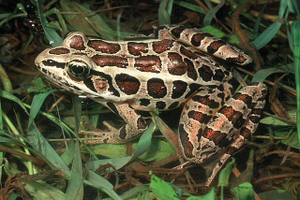Pickerel frogs have a distinctive odor and bright colors that are thought to advertise their distasteful skin secretions, and some predators such as shrews, certain fishes, and common garter snakes may reject them as food.
Photo Credit: Geoffrey A. Hammerson
Lithobates palustris
Common Name: pickerel frog
Other Scientific Names: Rana palustris
Animal Guild: Amphibian
Class > Order > Family: Amphibia > Anura > Ranidae
What does the species look like?
The upper surface is tan with two parallel rows of more or less rectangular dark spots along the middle of the back. The base of the hind legs and groin are yellow or orange, though this color is faint or absent in juveniles. A light stripe runs along the upper jaw. A glandular ridge extends along each side of the back. The hind toes are extensively webbed. Maximum size is around 3.5 inches (8.7 cm) snout-vent length. Breeding males have forelimbs that are more massive than those of females and juveniles, and the base of the thumb is larger in breeding males than in adult females. Breeding call is a low snore lasting 1-2 seconds. Larvae are not particularly distinctive; the upper side is green with small black and yellow spots; tail fins are low, with heavy dark mottling; and the eyes are not at the margins of the head when viewed from above. Maximum total length of larvae is about 3 inches (7.5 cm). Eggs are laid in firm spherical masses containing up to a few thousand eggs.
Where is the species found?
States & Provinces
AL, AR, CT, DC, DE, GA, IA, IL, IN, KS, KY, LA, MA, MD, ME, MI, MN, MO, MS, NB, NC, NH, NJ, NS, NY, OH, OK, ON, PA, PE, QC, RI, SC, TN, TX, VA, VT, WI, WV
Distribution
Range extends from the Gaspe Peninsula of Quebec to Wisconsin, and south to southern South Carolina, northern Georgia, southern Mississippi, and southeastern Texas. This frog is absent from most of the far southeastern United States (e.g., Florida, southern Georgia) and the prairie region of Illinois and vicinity.
Pickerel frogs occur in various freshwater aquatic and wetland habitats in wooded regions, ranging from the vicinity of cool clear streams and ponds in the north to warm, turbid swamps in parts of the south. In summer, they commonly range into fields and woods away from ponds or streams. Breeding sites include standing water of woodland ponds, bog ponds, impoundments, stream pools, sloughs, and flooded ditches, often but not always in sites with few or no fishes. Males call while floating or submerged. Females attach egg masses to submerged vegetation.
General Phenology and Life History
In the northern part of the range, pickerel frogs are mostly inactive during the coldest winter months, when they may be hidden at the bottom of a water body or secluded in wet caves. Breeding occurs in winter in the far south, in spring (mostly April-May) in the north. Larvae hatch in several days or up to three weeks after laying, and they metamorphose usually within 2-3 months, in summer (often July-August in the north).
Which phenophases should I observe?
Do you see/hear...?
Activity
Adults on land More...
For abundance, enter the number of individual animals observed in this phenophase.
Adults in water More...
For abundance, enter the number of individual animals observed in this phenophase.
Adults feeding For abundance, enter the number of individual animals observed in this phenophase.
Reproduction
Vocalizing What is the intensity of vocalizing?
Single calls: There is space between calls and individuals can be counted. Overlapping calls: Calls of individuals can be distinguished but there is some overlapping of calls. Full chorus: Calls are constant and overlapping.
Mating For abundance, enter the number of individual animals observed in this phenophase.
Fresh eggs For abundance, enter the number of individual animals observed in this phenophase.
Development
Dead adults For abundance, enter the number of individual animals observed in this phenophase.
What do these phenophases look like?
There is currently no photoguide available for this species. If you'd like help us create one, use the guidance document and species template provided here . Then send it via email to education@usanpn.org when it is complete.
